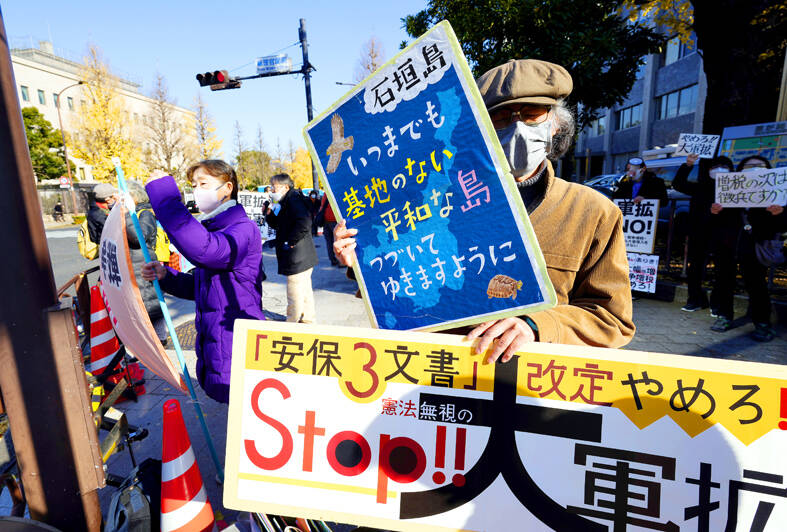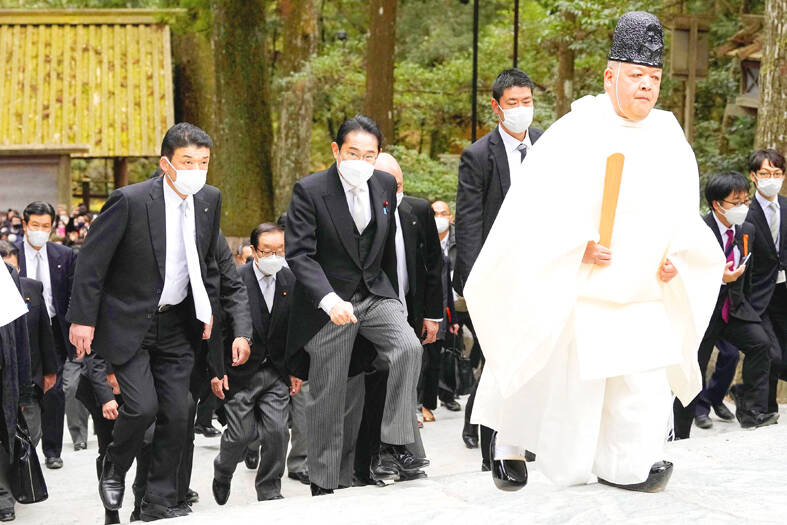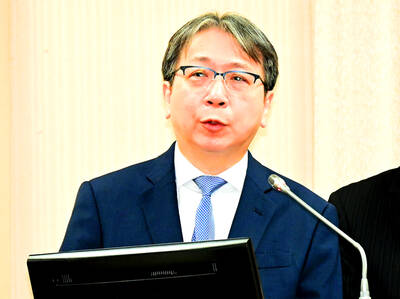East Asia could be the next Ukraine, Japanese Prime Minister Fumio Kishida said on Saturday, adding that he had conveyed this message to Western leaders in recent talks, urging them to join a united front on a rising China and bellicose North Korea.
At the start of Japan’s year-long G7 presidency, Kishida visited leaders of all members of the elite club except Germany, where he plans to go soon.
Closing his trip in Washington, Kishida said he shared with G7 leaders his “strong sense of crisis regarding the security environment in East Asia.”

Photo: EPA-EFE
“Ukraine may be the East Asia of tomorrow,” Kishida told a news conference a day after meeting US President Joe Biden, calling security concerns in Europe and East Asia “inseparable.”
“The situation around Japan is becoming increasingly severe with attempts to unilaterally change the status quo by force in the East China Sea and South China Sea, and the activation of North Korea’s nuclear and missile activities,” he said.
Kishida was referring to China’s growing assertiveness in the two areas, where Beijing has a slew of island disputes including with Japan, the Philippines and Vietnam.

Photo: REUTERS / Kyodo
China in August also fired missiles into Japan’s exclusive economic zone when it conducted major military exercises around Taiwan.
Kishida traveled to Washington after his administration announced that Japan would double its defense spending over the next five years, a sea change for a country that has been officially pacifist since its defeat in World War II.
Kishida said he would work to “explain thoroughly to the public” the need to use tax money to ramp up defense spending to 2 percent of GDP — a goal separately set by NATO that more countries are accepting since Russia’s invasion of Ukraine.
Among other steps taken under a new defense strategy, Japan would develop “counterstrike” capacity to hit threatening launch sites and hopes to buy hundreds of Tomahawk cruise missiles, now only in the arsenals of the US and the UK.
Kishida said he spoke with the British and Italian prime ministers about moving a three-way development of a next-generation fighter jet that uses artificial intelligence.
Kishida said Japan has not yet decided whether to join the US on one measure that has especially irritated China — cutting it off from imports of semiconductors critical for advanced technology.
“Semiconductors are part of economic security including for the United States and like-minded countries. We want to have closer communication to think about how to treat this issue,” Kishida said.
Japan is proud to be the only Asian member of the G7, and Kishida has said that his administration’s response on Ukraine effectively internationalized Western-led opposition to Russia’s invasion.
In turn, Kishida earlier said in Washington that Japan needs to be able to rely on “allies and like-minded countries” on risks from China.
“China needs to make a strategic decision that it will abide by the established international rules and that it cannot and will not change the international order in ways that are contrary to these rules,” he said on Friday at Johns Hopkins University’s School of Advanced International Studies.
Kishida said that Japan still sees itself as a “peace-loving” nation and would use the G7 to push for the eventual abolition of nuclear weapons.
The leaders of the G7 — Britain, Canada, France, Germany, Italy, Japan and the US — are to hold a summit in May in Hiroshima, Japan, the site of the world’s first nuclear attack and Kishida’s parliamentary constituency.

The US government has signed defense cooperation agreements with Japan and the Philippines to boost the deterrence capabilities of countries in the first island chain, a report by the National Security Bureau (NSB) showed. The main countries on the first island chain include the two nations and Taiwan. The bureau is to present the report at a meeting of the legislature’s Foreign Affairs and National Defense Committee tomorrow. The US military has deployed Typhon missile systems to Japan’s Yamaguchi Prefecture and Zambales province in the Philippines during their joint military exercises. It has also installed NMESIS anti-ship systems in Japan’s Okinawa

TRAGEDY STRIKES TAIPEI: The suspect died after falling off a building after he threw smoke grenades into Taipei Main Station and went on a killing spree in Zhongshan A 27-year-old suspect allegedly threw smoke grenades in Taipei Main Station and then proceeded to Zhongshan MRT Station in a random killing spree that resulted in the death of the suspect and two other civilians, and seven injured, including one in critical condition, as of press time last night. The suspect, identified as a man surnamed Chang Wen (張文), allegedly began the attack at Taipei Main Station, the Taipei Fire Department said, adding that it received a report at 5:24pm that smoke grenades had been thrown in the station. One man in his 50s was rushed to hospital after a cardiac arrest

‘WIN-WIN’: The Philippines, and central and eastern European countries are important potential drone cooperation partners, Minister of Foreign Affairs Lin Chia-lung said Minister of Foreign Affairs Lin Chia-lung (林佳龍) in an interview published yesterday confirmed that there are joint ventures between Taiwan and Poland in the drone industry. Lin made the remark in an exclusive interview with the Chinese-language Liberty Times (the Taipei Times’ sister paper). The government-backed Taiwan Excellence Drone International Business Opportunities Alliance and the Polish Chamber of Unmanned Systems on Wednesday last week signed a memorandum of understanding in Poland to develop a “non-China” supply chain for drones and work together on key technologies. Asked if Taiwan prioritized Poland among central and eastern European countries in drone collaboration, Lin

ON ALERT: Taiwan’s partners would issue warnings if China attempted to use Interpol to target Taiwanese, and the global body has mechanisms to prevent it, an official said China has stationed two to four people specializing in Taiwan affairs at its embassies in several democratic countries to monitor and harass Taiwanese, actions that the host nations would not tolerate, National Security Bureau (NSB) Director-General Tsai Ming-yen (蔡明彥) said yesterday. Tsai made the comments at a meeting of the legislature’s Foreign Affairs and National Defense Committee, which asked him and Minister of National Defense Wellington Koo (顧立雄) to report on potential conflicts in the Taiwan Strait and military preparedness. Democratic Progressive Party (DPP) Legislator Michelle Lin (林楚茵) expressed concern that Beijing has posted personnel from China’s Taiwan Affairs Office to its